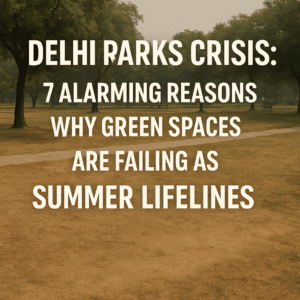Delhi Parks Crisis: 7 Alarming Reasons Why Green Spaces Are Failing as Summer Lifelines
Delhi’s public parks, despite their cooling potential, are failing as summer refuges due to poor infrastructure and access barriers. A recent audit of 50 parks revealed shaded areas can be 20°C cooler than exposed zones, yet critical shortcomings persist: 76% lack drinking water, 64% lock gates at night when heat lingers, and only 28% have functional water bodies. Excessive concretization—encasing tree roots and replacing soil with tiles—undermines natural cooling and tree health.
While Delhi claims 25% green cover, functional parks cluster in affluent areas, leaving vulnerable neighborhoods without relief. The report urges 24/7 park access, banning root concretization, installing water points, and integrating biodiversity support to transform parks into equitable, life-saving infrastructure during intensifying heatwaves.

Delhi Parks Crisis: 7 Alarming Reasons Why Green Spaces Are Failing as Summer Lifelines
A scorching Delhi summer, one for the record books, has exposed a critical flaw in the city’s climate defence: its public parks are largely failing as places of refuge. A stark new audit of 50 parks across the capital reveals not just the potential for relief, but a systemic failure to deliver it when citizens need it most.
The Cooling Power (and Stark Reality): The study, conducted by Greenpeace India with COHAS and Youth for Climate Justice South Asia, delivered undeniable proof of nature’s power. Thermal imaging showed shaded, tree-covered areas in parks could be a staggering 20 degrees Celsius cooler than exposed concrete patches. On average, this life-saving difference was 10 degrees Celsius. Imagine peak surface temperatures hitting 53.3°C on sun-baked concrete, while under trees, it was a far more bearable 35°C.
Yet, Relief Remains Out of Reach: This potential, however, is crippled by neglect and poor planning. The audit paints a picture of parks ill-equipped to serve as heat sanctuaries:
- The Thirst Trap: A shocking 76% of parks lacked public drinking water points. In extreme heat, access to water isn’t a convenience; it’s a matter of health and safety.
- Locked Out When It Matters Most: Despite heat lingering long into the night, especially in low-income areas, 74% of parks were closed during parts of the day, and 64% were locked at night. As Priyanka from COHAS poignantly stated, this realization hit hard: “parks aren’t luxuries, they are life-saving infrastructure.”
- Biodiversity Blind Spot: While 73% of parks had water bowls for animals and birds, none had officially installed shelters. Nearly all existing provisions were set up by residents or informal caretakers, highlighting a lack of institutional support for urban ecology.
- Drying Up: Only 28% of parks featured any water body, and many of these were found to be drying or poorly maintained, further reducing their cooling effect.
- The Concrete Strangler: The audit documented alarming “concretisation” – tree roots encased in cement, permeable soil replaced with tiles or paving. This not only kills the natural cooling capacity of the soil but actively harms the health and longevity of the trees themselves, the very source of the vital shade.
Beyond the 25% Green Cover Myth: While Delhi boasts an official 25% green cover (2023 State of Forest Report), the audit revealed this number hides critical disparities. Functional parks – those with actual tree canopy, walkable soil, and basic usability – are concentrated in more affluent southern and central districts. Many parks elsewhere are green in name only, lacking the structure to provide real respite.
Reimagining Parks as Essential Urban Infrastructure: The ‘Delhi Rising’ campaign, which spearheaded the audit, isn’t just diagnosing the problem; it’s proposing concrete solutions for policymakers (DDA, NDMC, Delhi Government):
- Access is Life: Guarantee 24/7 access to at least one functional green space within every residential zone, especially heat-vulnerable areas.
- Basic Humanity: Install public drinking water facilities and shaded seating areas in all major parks.
- Free the Trees: Implement an immediate ban on further concretisation around tree bases and roots. Prioritise permeable surfaces.
- Biodiversity as Standard: Legally protect remaining urban forest patches (Dwarka, Aravalli, Sanjay Van) and mandate biodiversity infrastructure – native plant species, bird shelters, functional water bodies – in park design and management.
- Community Partnership: Formalize and support resident associations actively maintaining parks, rather than leaving it to chance.
The Burning Question: As heatwaves intensify in frequency and ferocity, this audit forces Delhi to confront a fundamental question: Who gets access to life-saving cool refuge, and who is left to swelter? Parks are not merely decorative. They are critical, frontline infrastructure in the climate emergency. Treating them as such – with investment, intelligent design, and unwavering public access – isn’t optional; it’s a matter of urban survival. The solutions are clear; the political will to implement them is the missing piece.
You must be logged in to post a comment.